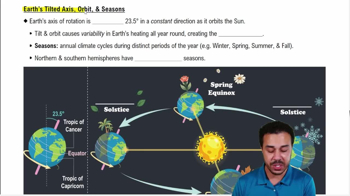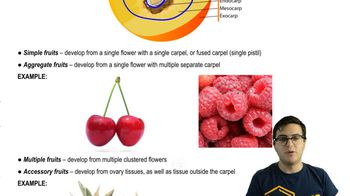Table of contents
- 1. Introduction to Biology2h 42m
- 2. Chemistry3h 40m
- 3. Water1h 26m
- 4. Biomolecules2h 23m
- 5. Cell Components2h 26m
- 6. The Membrane2h 31m
- 7. Energy and Metabolism2h 0m
- 8. Respiration2h 40m
- 9. Photosynthesis2h 49m
- 10. Cell Signaling59m
- 11. Cell Division2h 47m
- 12. Meiosis2h 0m
- 13. Mendelian Genetics4h 44m
- Introduction to Mendel's Experiments7m
- Genotype vs. Phenotype17m
- Punnett Squares13m
- Mendel's Experiments26m
- Mendel's Laws18m
- Monohybrid Crosses19m
- Test Crosses14m
- Dihybrid Crosses20m
- Punnett Square Probability26m
- Incomplete Dominance vs. Codominance20m
- Epistasis7m
- Non-Mendelian Genetics12m
- Pedigrees6m
- Autosomal Inheritance21m
- Sex-Linked Inheritance43m
- X-Inactivation9m
- 14. DNA Synthesis2h 27m
- 15. Gene Expression3h 20m
- 16. Regulation of Expression3h 31m
- Introduction to Regulation of Gene Expression13m
- Prokaryotic Gene Regulation via Operons27m
- The Lac Operon21m
- Glucose's Impact on Lac Operon25m
- The Trp Operon20m
- Review of the Lac Operon & Trp Operon11m
- Introduction to Eukaryotic Gene Regulation9m
- Eukaryotic Chromatin Modifications16m
- Eukaryotic Transcriptional Control22m
- Eukaryotic Post-Transcriptional Regulation28m
- Eukaryotic Post-Translational Regulation13m
- 17. Viruses37m
- 18. Biotechnology2h 58m
- 19. Genomics17m
- 20. Development1h 5m
- 21. Evolution3h 1m
- 22. Evolution of Populations3h 52m
- 23. Speciation1h 37m
- 24. History of Life on Earth2h 6m
- 25. Phylogeny2h 31m
- 26. Prokaryotes4h 59m
- 27. Protists1h 12m
- 28. Plants1h 22m
- 29. Fungi36m
- 30. Overview of Animals34m
- 31. Invertebrates1h 2m
- 32. Vertebrates50m
- 33. Plant Anatomy1h 3m
- 34. Vascular Plant Transport1h 2m
- 35. Soil37m
- 36. Plant Reproduction47m
- 37. Plant Sensation and Response1h 9m
- 38. Animal Form and Function1h 19m
- 39. Digestive System1h 10m
- 40. Circulatory System1h 57m
- 41. Immune System1h 12m
- 42. Osmoregulation and Excretion50m
- 43. Endocrine System1h 4m
- 44. Animal Reproduction1h 2m
- 45. Nervous System1h 55m
- 46. Sensory Systems46m
- 47. Muscle Systems23m
- 48. Ecology3h 11m
- Introduction to Ecology20m
- Biogeography14m
- Earth's Climate Patterns50m
- Introduction to Terrestrial Biomes10m
- Terrestrial Biomes: Near Equator13m
- Terrestrial Biomes: Temperate Regions10m
- Terrestrial Biomes: Northern Regions15m
- Introduction to Aquatic Biomes27m
- Freshwater Aquatic Biomes14m
- Marine Aquatic Biomes13m
- 49. Animal Behavior28m
- 50. Population Ecology3h 41m
- Introduction to Population Ecology28m
- Population Sampling Methods23m
- Life History12m
- Population Demography17m
- Factors Limiting Population Growth14m
- Introduction to Population Growth Models22m
- Linear Population Growth6m
- Exponential Population Growth29m
- Logistic Population Growth32m
- r/K Selection10m
- The Human Population22m
- 51. Community Ecology2h 46m
- Introduction to Community Ecology2m
- Introduction to Community Interactions9m
- Community Interactions: Competition (-/-)38m
- Community Interactions: Exploitation (+/-)23m
- Community Interactions: Mutualism (+/+) & Commensalism (+/0)9m
- Community Structure35m
- Community Dynamics26m
- Geographic Impact on Communities21m
- 52. Ecosystems2h 36m
- 53. Conservation Biology24m
36. Plant Reproduction
Seeds
Problem 4`
Textbook Question
When does the apical–basal axis first become apparent?
a. When the epidermal, ground, and vascular tissues form
b. When the cotyledons, hypocotyl, and root form
c. When the first cell division produces the apical cell and basal cell
d. During the globular stage, when the suspensor is complete
 Verified step by step guidance
Verified step by step guidance1
Understand the concept of the apical-basal axis: In plant development, the apical-basal axis is a fundamental organizational feature that determines the orientation of the plant body, from the shoot (apical) to the root (basal).
Consider the stages of plant embryogenesis: The development of a plant embryo involves several stages, starting from a single fertilized egg cell to a fully formed embryo with distinct tissues and organs.
Identify the role of the first cell division: The first division of the zygote is asymmetric, producing two cells with different fates: the apical cell, which will give rise to most of the embryo, and the basal cell, which will contribute to the formation of the suspensor.
Analyze the options: Option c refers to the first cell division producing the apical and basal cells, which is a critical event in establishing the apical-basal axis.
Conclude based on the analysis: The apical-basal axis first becomes apparent during the first cell division when the apical and basal cells are formed, as this division sets the foundation for the subsequent development of the plant's body plan.
 Verified video answer for a similar problem:
Verified video answer for a similar problem:This video solution was recommended by our tutors as helpful for the problem above
Video duration:
50sPlay a video:
Was this helpful?
Key Concepts
Here are the essential concepts you must grasp in order to answer the question correctly.
Apical-Basal Axis
The apical-basal axis is a fundamental organizational feature in plant development, establishing the primary growth direction from the shoot (apical) to the root (basal). This axis is crucial for determining the spatial arrangement of tissues and organs in plants, guiding the differentiation of cells into specific structures like leaves, stems, and roots.
Recommended video:
Guided course

Earth’s Tilted Axis, Orbit, & Seasons
Cell Division in Plant Embryogenesis
In plant embryogenesis, the first cell division is pivotal as it produces two distinct cells: the apical cell, which will give rise to most of the embryo, and the basal cell, which contributes to the formation of the suspensor. This division marks the initial establishment of the apical-basal axis, setting the stage for subsequent developmental processes.
Recommended video:
Guided course

Importance of Cell Division
Globular Stage of Embryo Development
The globular stage is an early phase in plant embryo development characterized by a spherical shape. During this stage, the basic body plan of the plant is established, including the completion of the suspensor, which supports the embryo. This stage is crucial for further differentiation and the establishment of the apical-basal axis.
Recommended video:
Guided course

Stages of Photosynthesis
Related Videos
Related Practice





















